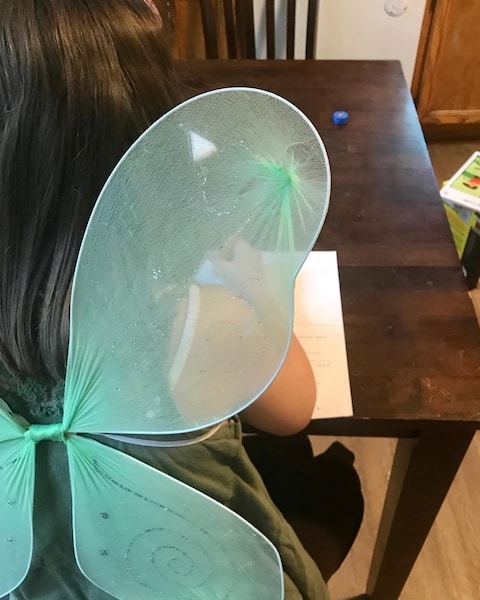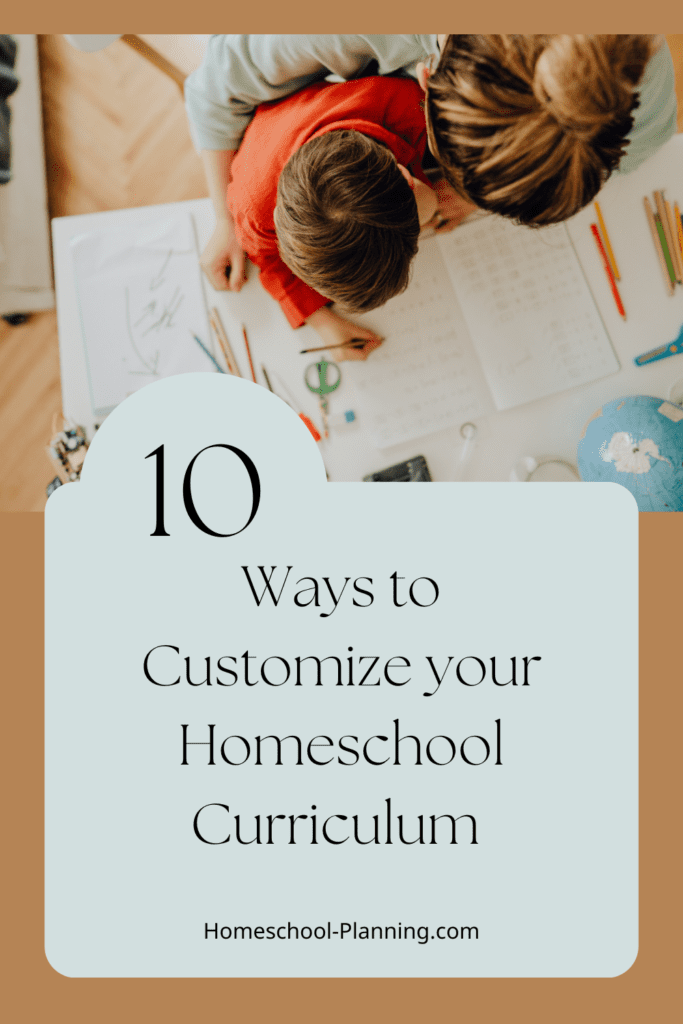Do you stress over picking curriculum? Wondering if you picked well, or if this will be what will work for your child? I do! But I’m here to remind you that no matter what homeschool curriculum you choose, it can always be changed to meet your specific needs.
Don’t get stuck thinking that you need to use it exactly or else you won’t get results. Investing money doesn’t equal perfection or require you to be a slave to the book.
Homeschool resources should be tools to help your children to learn. Don’t trap yourself or your children. Make the books work for you!
Keep reading for 10 easy ways to make any homeschool curriculum work for you!

Add fun
When your homeschool curriculum is getting boring, add in some fun! Learning doesn’t have to just be books and tests so add in some fun games or crafts. Supplement the topic with a YouTube video or field trip. Making learning more interactive and hands-on can make any topic more interesting.
There are tons of places to find these ideas and options. Doing a quick search online or on Pinterest will get you some quick options! Or come up with your own fun ideas, based on the topic.
But remember, FUN is the goal – not busywork!
Here are some general ideas:
- Go on a field trip
- Visit a museum
- Play a game
- Draw or color a picture
- Make up a story
- Build it (play dough, sand, craft supplies, cardboard, etc.)
- Memorize a related poem
- Act it out
- Do a craft
- Cook something
- Watch a movie
- Read a related (fiction) book
- Watch YouTube videos on the topic
- Do an online search and see where it leads
- Follow the related rabbit trails
- Talk with someone who knows a lot on the subject
- Visit the library and find more books
- Find a printable worksheet
- Download or build a puzzle on the topic (crossword, word search, etc.)
Remove redundancy
Many curricula and resources have a ton of repeated information, so it can be helpful to remove the redundancy. If your child is bored and overwhelmed with the amount of school work they have to do, this is often a good place to start.
A common way to build out a curriculum is to teach a topic then complete many questions, quizzes, activities, and projects based on the topic. Many times these will be similar and unnecessary to complete them all.
So much of it can just be busywork to fill time. Having students complete a worksheet with a lesson because “that’s what you do” rather than having the worksheet be meaningful and helpful to the lesson. Totally unnecessary.
Many math curricula will have problem after problem on the same new idea. There’s not always a need to do 20 problems every day for a whole week if they totally understood the topic in 5.
If your child understands the topic and wants to move on, there’s nothing saying you have to check every box on the page first. Just move on.

Skip some stuff
If the homeschooling resource you are using has activities or sections that don’t mesh well with your family, it’s ok to skip it.
You could think of curriculum like an all-you-can-eat buffet. You may go and eat a piece of chicken and be full and not need more. Another may be ravenous and eat a ton.
You also may enjoy a lot of the foods on the buffet, while your child eats only the macaroni and cheese. While it’s good to explore new foods, it’s also just fine to fill your plate with the foods you enjoy and leave the rest for others.
This is the same with curriculum. Use the pieces of the curriculum that work to fill the needs of your child and skip the rest. If they are really enjoying a topic, dive in. If not, teach them the basics and move on.
Even many curricula that have items included that are meant to be fun will not be fun to all children. Crafts and crossword puzzles will be seen as annoying and busy work for one student. But for another, they are what gets them through the lesson with a smile.
Some children will need the reinforcement of ideas, and others will catch on quickly. They can move on right away.
So learn what works well for your child, and what works well for you. Take what works and leave the rest on the buffet.
Too much reading? Read together
Sometimes reading is too much for a child, so read together! Especially for kids who are young and still learning to read, or those who struggle with reading. Large amounts of reading can be hindering to the learning process for some.
If your child is eager to learn, but is struggling because of reading, take the time to read with them.
If you have chosen a curriculum that is heavy in literature, consider reading the books together rather than having your child read them on his own. This will not only help him, but also build great memories together.
This should not take the place of encouraging them to read on their own, but knowing what is too much for your child is helpful. Plus the benefits of reading aloud to your children is extensive. It will never be bad for them.

Too much writing? Have a conversation
Many curricula are heavy on writing things out. Doing some work verbally may help some students continue to be successful with less tears. Have a conversation with your child about the topic rather than pushing them to write everything down.
I’m definitely not saying to skip writing all together in your homeschool. There are many reasons why writing is good for your children to practice. One is that it helps them develop how to think and present their thoughts in a clear way.
So while it should still be done, too much writing may actually hinder progress for some students. I have found that boys in particular seem to struggle with the act of writing. My son and I often discuss his work rather than writing down answers in a workbook.
Though we also have had many moments of tears when I required him to write. And you know what? He is now 12 and an incredible writer! I’m looking forward to seeing where life takes him.
The same can be true for a young child. If you have a young child that is eager to learn, but lots of writing holds them back, it’s ok to help them write some things down or work through it verbally. Some curricula encourage a lot of writing even though the child may still be learning to form letters which can really discourage a child.
Once again, it’s still good to encourage them to write on their own, but understand what is too much. Learning doesn’t have to stop just because writing is hard for them.
Remove tests or quizzes
Not all students respond well to testing so I give you permission to skip them. Many homeschool resources include tests or quizzes with the idea they help you test for understanding of the topic. But this is not the only way for a child to demonstrate understanding.
One popular way to have your children show what they have learned is to just discuss the topic with them. Ask some questions, or have them summarize what they just heard. You could even have them teach the topic back to you.
The fact also comes that not all subjects lend themselves easily to tests. Math is a black and white subject with straightforward answers that are easy to grade. But history or literature are more difficult to nail down into questions and answers without taking away a lot of the joy of the subject.
If tests and quizzes work well for your family, then continue for sure. But if you are using them just as a way to give a grade and in the process, you may consider removing them from your curriculum. Especially for younger children.
It’s possible you are driving the joy of learning out of your children. There are other ways to come up with a grade.

Use it as an outline
Curriculum should help you teach your kids as a tool. If you are finding it completely unhelpful, but still want to cover the topic well you could use the curriculum as an outline of topics to cover.
Use the table of contents for gathering subject areas to cover. It can be quite helpful if you are really struggling with a certain curriculum’s style. Feel free to use the topics as a starting point to find your own videos, books, and games to work through the subject on your own.
Knowing the topics to cover is often the most difficult part of teaching your children, so loosely using a curriculum then fleshing it out on your own may be the way to go for some.
This approach is also helpful if you have a higher lever curriculum you are needing to “dumb down” for a younger child. Or the opposite, increasing difficulty for an older child.
Finding alternative content can help you use the same book for multiple levels of children if you are wanting to put in a little extra work. It can also help you appeal to a child with a different learning style than the curriculum is designed for.
Keep what is important
When customizing curriculum to fit your needs, it’s good to know what your goals are for your child learning this subject. This will help you keep what is important to learn and understand what can be let go.
Perhaps you tend to allow your child to skip a lot of writing but are feeling this year they need to be challenged in this area. Maybe removing the extra writing isn’t what you should do this time.
On the other hand, perhaps experiments are important to you in science, but don’t feel that answering lots of questions and taking tests will help your child. Then skip the questions and focus more on doing good experiments.
Ultimately, curriculum is a tool to be used to help you teach your child. There are no curriculum police who will arrest you for changing things. You know you child better than anyone, so use the important parts in the way that works best for your family.

Build in breaks
You may find a homeschool curriculum is fast paced and difficult for your child. Building in some extra breaks may help lighten the load.
You could decide to work on that topic once a week and take your time through the lesson. Or switch to every other day. When piecing together curriculum, it can be easy to overload students.
You could also use a resource for a few weeks then work on another topic for a few weeks. No one says you have to do every subject every day.
In fact, sometimes it is helpful to take breaks from a topic as your brain will keep mulling it over and letting it settle. Then when you come back to it later, things are much easier.
I have seen this happen when teaching a child to read. They may be struggling hard and it’s just not clicking no matter what you try. So you lay it down for a bit. After a few weeks, you may pick it up and your child can all of the sudden read like a pro!
Maybe it’s burn-out, maybe it’s just the tincture of time. But taking a break – even building them in – can often help learning go much more smoothly.
In the end, learning is not a race. We have years to expose our children to many ideas. There is no need to cram in the information, especially when they are young.
Speed up or slow down
Perhaps the curriculum you have chosen turns out to be a little slow and boring for your child. Or it’s much too in-depth and difficult. It’s ok to slow down or speed up getting through the curriculum.
Sometimes you may find that certain topics are easy for your child. So teach them and move on. No need to dilly-dally if they get it. Other times you may need to scour the internet for supplementary work cause they are just not understanding.
This doesn’t mean there is a problem with your child, or necessarily with the curriculum either. Curriculum is written to appeal to a broad range of children, so it will likely never be perfect all the way through for your child.
Understanding this will revolutionize your homeschool and your approach to curriculum.
Allow for flexibility in your schedule so you have room to accommodate your children. Changing your plans, schedule, and goals as needed are important for meeting your child’s needs. Give yourself permission to do so.

An example
This year I ended up using several new curricula with my 12 year old. I have found there aren’t as many options for older homeschoolers as with grade schoolers and many of the resources I had been using don’t continue into middle and high school. Others I had just decided to make a change this year.
The first few weeks of school were rough. Every year brings new challenges, but throwing in several new books in to the mix added more struggles for us.
There were often tears, and school would take hours and hours on a regular basis. I knew this was not necessary!
One of the reasons I struggled was because I wanted to challenge my son. It was difficult to decide where the line between challenging and torturing unnecessarily was. I didn’t want to rob him of the joy of a subject he loves just because of busy work, but I also wanted to be sure I’m not letting him get out of doing hard things.
I knew he learns well with reading books and using workbooks in a “traditional school” way. So I knew there was a way to make this work somehow.
I ended up talking with another very experienced homeschool mom friend about it. I had narrowed it down to mostly one curriculum being an issue. With her encouragement, I thought through the parts of the curriculum that were important to me and what I felt was unnecessary. It has a large workbook with a lot of pages to complete each day.
Then my son and I sat down and discussed his issues and came up with a plan. Some parts he will skip, some parts he will discuss verbally with me. If he felt like a section was boring and redundant or unnecessary then he has the freedom to ask me about skipping it.
This has worked well for us and many days he is able to complete this curriculum in 15-30 minutes where in the beginning some days were taking an hour. And he has even mentioned enjoying it!
I’m so glad I followed my gut. I didn’t just force it onto my son and make him hate school. I also didn’t just give up and change curriculum. Instead, we found a compromise to make it work for us.
Conclusion
Finding homeschool curriculum can feel like a daunting task, and often we put too much pressure on ourselves to find the perfect resource. The truth is, there is not a perfect curriculum that will check all your boxes perfectly.
So when you find yourself wondering if you chose poorly or if there is another option that’s better out there, remember that there are many ways to customize a homeschool resource to fit your needs. Remove things, add things, change how it’s done, or set your own pace.
Homeschool curriculum should be a tool to help you teach your child. Not a source of stress or something that boxes you in. You should not feel like a slave to your curriculum.
So when things get tough and you wonder if you should toss what you’re using, decide what is important and make your curriculum work for you.
What ways have you adjusted your homeschool curriculum to fit your needs? Comment below!
Related Posts
Tips for choosing homeschool curriculum
Customize any planner to work for you




